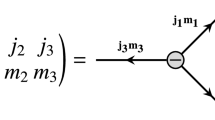Abstract
In this work, we present the mapping formulae for the contraction of the third-order reduced density matrices represented in the basis of the irreducible representations (IR) of the symmetric group S3 into the second-order ones which are represented in the basis of the IR of group S2. These algorithms, which can be useful in several fields, have been applied for the approximation of reduced density matrices within the spin-adapted reduced Hamiltonian theory. Some results obtained with this procedure are also presented.
Similar content being viewed by others
References
J. Karwowski, W. Duch and C. Valdemoro, Phys. Rev. A33 (1986)2254.
L. Lain, A. Torre, J. Karwowski and C. Valdemoro, Phys. Rev. A38 (1988)2721.
J. Planelles, C. Valdemoro and J. Karwowski, Phys. Rev. A43 (1991)3392.
C. Valdemoro, L. Lain, F. Beitia, A. Ortiz and F. Castaño, Phys. Rev. A33 (1986)1525.
L. Lain, C. Valdemoro, A. Torre and M. Reguero, Phys. Rev. A35 (1987)3132.
M. Reguero and C. Valdemoro, in:Basic Aspects of Quantum Chemistry, ed. R. Carbó (Elsevier, Amsterdam, 1989).
L. Lain, A. Torre and C. Valdemoro, Phys. Rev. A37 (1988)2868.
D.L. Cooper, J. Gerratt and M. Raimondi, Chem. Rev. 91 (1991)929, and references therein.
J. Paldus and B. Jeziorski, Theor. Chim. Acta 73 (1988)81.
M. Moshinsky,Group Theory and the Many-Bondy Problem (Gordon and Breach, New York, 1968).
J. Paldus, in:Theoretical Chemistry: Advances and Perspectives, ed. H. Eyring and D.J. Henderson (Academic Press, New York, 1976).
J. Koutecky and A. Laforgue, Int. J. Quant. Chem. 11 (1977)505.
J. Hinze and J.T. Broad, in:Lecture Notes in Chemistry, Vol. 22, ed. J. Hinze (Springer, Berlin, 1981) p. 332.
M.A. Robb and U. Niazi, Comput. Phys. Rep. 1 (1984)127.
W. Duch and J. Karwowski, Comput. Phys. Rep. 2 (1985)95.
W. Kutzelnigg, J. Chem. Phys. 82 (1985)4166, and references therein.
C. Valdemoro, A. Torre and L. Lain, in:Structure, Interactions and Reactivity, ed. S. Fraga (Elsevier, Amsterdam, 1992).
C.E. Moore,Ionization Potentials and Ionization Limits Derived from the Analysis of Optical Spectra, National Bureau of Standards (US) Spec. Publ. No. 34 (US GPO, Washington, 1970).
S. Fraga, J. Karwowski and K.M.S. Saxena,Handbook of Atomic Data (Elsevier, Amsterdam, 1976).
E. Clementi and C. Roetti, At. Data Nucl. Data Tables 14 (1974)428.
Author information
Authors and Affiliations
Rights and permissions
About this article
Cite this article
Tone, A., Lain, L. & Millan, J. Contraction algorithms for third-order reduced density matrices: Symmetric group approach. J Math Chem 13, 177–189 (1993). https://doi.org/10.1007/BF01165563
Received:
Issue Date:
DOI: https://doi.org/10.1007/BF01165563




